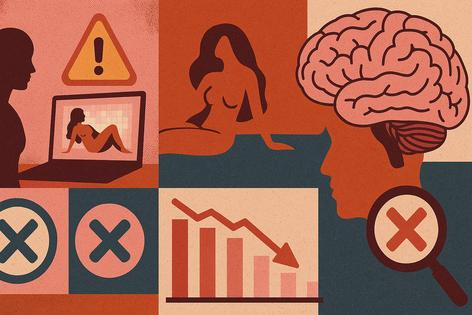Pornography may be commonplace, but a growing body of research shows it causes lasting harm to the brain and relationships
Published in Health & Fitness
While pornography has been present throughout human history in various forms, such as ancient erotic art to more modernized motion pictures, research shows an increase in use over recent decades given the rise of technology and accessibility.
Pornography, meaning any media intended to depict or describe sexual content to heighten sexual arousal or pleasure, can serve many purposes. Users may seek sexual pleasure, find it a fun way to fight boredom, or turn to it because they are down or stressed and perhaps want to escape their feelings.
Statistics show pornography to be commonplace: A 2018 study found that 91.5% of men and 60.2% of women had consumed it in the past month.
It’s important to ask: What does viewing explicit materials do to your brain and real-life sexual and romantic relationships, and specifically to the people who see it when they are as young as 10 years old or even earlier?
I am a licensed marriage and family therapist specializing in the treatment of a variety of mental health challenges. These include issues that are often seen in the context of relationships and larger systems such as media and pornography.
While neither problematic pornography use nor addiction to it is listed in the handbook used for mental health diagnostics, known as the DSM, it may still be detrimental for many people in terms of their behavior, their relationships and their mental and physical well-being. People with problematic porn use have trouble reducing or controlling their pornography use despite the harm it does to their life.
I will walk through some of these consequences below, starting with how the brain can be changed with pornography use.
While some of the most pertinent studies were done a decade ago or more, they remain highly relevant. Conducting research in this arena can be difficult due to the DSM’s exclusion of pornography “addiction” as a disorder as well as the sensitive nature of the topic. Controlled experiments on humans, particularly of this kind, are inherently unethical, therefore studies rely on surveys and reports.
A 2015 study − one of the first brain scan studies on male pornography users − found a correlation between pornography use and reduced gray matter in part of the brain’s reward system involved in motivation and decision-making. The study also reported lower responsiveness to pornography and other sexual stimuli due to desensitization.
This pattern likely results from lower connectivity between the prefrontal cortex − the decision-making part of the brain − and the reward as more porn is consumed. This in turn leads to increased cravings and impulsivity in order to achieve the previous levels of reward in the brain.
Another study, published in 2016, found that 49% of subjects had experienced pursuing content that was previously not interesting to them or that they considered disgusting. Because pornography can affect brain changes and subsequent pleasure responses, porn users may eventually feel the need to seek more extreme content.
This pursuit, in attempts to override the chemistry of the changing brain, may lend to disruption in the person’s life, often within relationships.
So what does this look like and how are relationships suffering as a result?
While some research suggests that pornography use can positively support sexuality exploration in couples, including increased quality and frequency of sex with use of pornography, most studies highlight its negative impact on intimate relationships.
The use of pornography is often associated with less relationship satisfaction and stability. Higher rates of infidelity, lower levels of commitment, increased emotional detachment and loss of trust are also evident in relationships affected by problematic porn use. The challenges related to unrealistic expectations, decreased sexual interest in a partner and increased partner insecurity influenced by pornography use have also been reported.
One 2011 survey found that women more often told researchers that they had less sex as a result of their partner’s pornography use, and men reported being less aroused by sex with their partner. A 2021 study looking at the correlation between pornography use and sexual dysfunction in young men ages 18-35 found that more than 20% of sexually active participants reported some degree of erectile dysfunction in the month prior to the questionaire. This contrasts to 8% in men 20-29 and 11% in the 30-39 age group, based on a study of the general prevalence of erectile dysfunction across several countries.
Given the prevalence of pornography use as well as data that indicates that consuming porn can damage relationships between intimate partners, what can couples do about it?
Since pornography use is often associated with shame and secrecy, it’s important for affected couples experiencing problems because one of them is consuming too much porn to openly discuss it to move through these challenges and work together as a team.
Talking with loved ones and trusted support, such as close friends, about difficult issues is known to reduce shame, making taboo subject areas more approachable.
I highly recommend seeking support from licensed therapists, especially those who specialize in the treatment of problematic pornography use, given the sensitive nature. In addition, peer support groups can be helpful in creating a sense of community and reducing isolation.
It’s no surprise that pornography is getting into the hands of young people at earlier ages as accessibility via cellphones and internet use has been increasing.
One 2022 study from Common Sense Media, an organization dedicated to helping parents navigate suitable media content for their children, reported that 73% of study respondents between the ages of 13 and 17 have watched porn. This differs from previous decades. For example, a study conducted in 2005 found 42% of youth internet users had been exposed to pornographic content.
The 2022 study found that 54% of these young people said they had been exposed to it before reaching the age of 13, and 15% at the age of 10 or younger. About 58% said they had accidentally encountered pornographic material.
Young people’s exposure to pornography can be disturbing to them and may be linked to higher rates of personality and impulse disorders.
Those who are exposed to pornography at earlier ages may also end up with unrealistic views of sexual behavior and beliefs, as well as earlier sexual exploration in comparison to those who aren’t.
Pornography use could have even more profound effects on the developing brain. This is because adolescent brains are undergoing rapid development, and connections are being formed and reorganized at a high rate of speed during the teen years, a physiological concept called neuroplasticity.
A 2021 study of almost 11,000 European adolescents between the ages of 14 and 17 found those exposed to pornography were more likely to engage in rule-breaking and aggressive behaviors.
These patterns drive home the great need for parental involvement in their children’s internet activity.
This article is republished from The Conversation, a nonprofit, independent news organization bringing you facts and trustworthy analysis to help you make sense of our complex world. It was written by: Danielle Sukenik, University of Colorado Anschutz Medical Campus
Read more:
What parents and educators need to know about teens’ pornography and sexting experiences at school
‘Sex addiction’ isn’t a justification for killing, or really an addiction – it reflects a person’s own moral misgivings about sex
Legal fight against AI-generated child pornography is complicated – a legal scholar explains why, and how the law could catch up
Danielle Sukenik does not work for, consult, own shares in or receive funding from any company or organization that would benefit from this article, and has disclosed no relevant affiliations beyond their academic appointment.











Comments